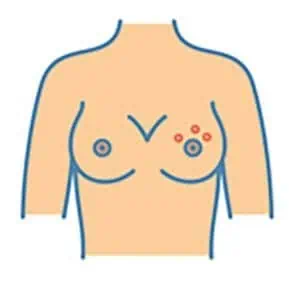
A breast lump is the classic sign of breast cancer, but it’s not the only sign. In rare cases, breast cancer can cause skin changes that offer early clues to the disease, according to dermatologist and dermatopathologist Ted Schiff, MD, founder and chief medical officer of Water’s Edge Dermatology. It’s much more likely that another, less-serious condition is the cause, but the following signs and symptoms could potentially indicate breast cancer and merit a trip to the doctor.
- A reddish rash. A reddish or purplish patch on the breast, either flat or slightly raised, could be a symptom of inflammatory breast cancer (IBC). This form of breast cancer, which is typically aggressive, occurs when cancer cells clog lymph vessels in the skin. IBC is quite rare, making up just 1% to 5% of all breast cancers. The breast may also be swollen and the skin may feel warm. But don’t panic if you develop these symptoms. “Most of these cases are not breast cancer,” said Dr. Schiff. Other possible causes of a red rash on the breast include a fungal infection, psoriasis, eczema and contact dermatitis.
- Dimpling. IBC can change the skin’s texture from smooth to dimpled, like an orange peel (the symptom is sometimes called peau d’orange, French for “skin of an orange”). In addition to the pebbly appearance and feel, the skin may become firm. Other possible causes of peau d’orange include cellulitis, a bacterial infection.
- Inverted nipple. If one of your nipples begins to pull inward, don’t ignore it. “A nipple that inverts can be an early sign of breast cancer,” said Dr. Schiff. Inverted nipples might be accompanied by other skin changes linked to breast cancer, such as skin dimpling. However, certain infections and other conditions can make a nipple turn inward, too. And some people are born with inverted nipples.
- Red, scaly nipple and areola. Paget’s disease of the breast is another rare form of breast cancer. “This type of breast cancer starts in a nipple,” said Dr. Schiff. The nipple may look red and/or scaly and may itch. The symptoms may spread to the areola, the ring of colored flesh around the nipple.
Dr. Schiff stressed that the majority of patients he sees with breast skin changes do not have breast cancer. Most have a condition that responds well to common treatments. For example, a rash on the breast caused by eczema usually clears up with cortisone cream. For an infection, antibiotics usually do the trick.
But go back to the doctor promptly if the treatment prescribed doesn’t seem to be working. “Symptoms that are persistent or recurrent should be evaluated,” said Dr. Schiff. The doctor may perform a skin biopsy, in which a small amount of tissue is removed and examined. Every now and then, Dr. Schiff or one of his colleagues detects breast cancer, and in those cases, the patient is referred to an oncologist for care.
Women who have a family history of breast cancer should be especially vigilant about watching for any signs and symptoms of breast cancer, including skin changes, and should talk with their gynecologist about appropriate screening, said Dr. Schiff.
Article Written By: Timothy Gower, an award-winning journalist who writes about medicine and health. His work has appeared in more than two dozen national magazines.
Medical Review By: Ted Schiff, MD





